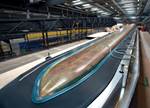Marine machining pioneer
Mollicam (Merritt Island, Fla.) was one of the first companies to bring a practical method of automated pattern construction into the marine industry.
Founded in 1991, Mollicam (Merritt Island, Fla.) was one of the first companies to bring a practical method of automated pattern construction into the marine industry, adapting technology from the automotive and aerospace industries and developing innovative materials and methods to accommodate larger parts while reducing cost. Mollicam cofounder Jeremy Mollica had worked for boatbuilder Sea Ray (Knoxville, Tenn.), and knew well the problems: Composite boatbuilders often encountered CAD designs that couldn’t be molded, and those that could be molded were imprecise. A 20-ft to 30-ft (6.1m to 9.14m) mold could easily be 0.5 inch/12.7 mm out of specification, from one side to the other.
Mollicam set out to develop its own, custom-made large-envelope CNC machines that could produce the computer-drafted design with a high degree of accuracy, but without a huge price tag. Mollicam immediately upped the standard for accuracy — today, the company uses an overhead gantry-style system that enables the CNC tool to remain perpendicular to the part surface at point. The result is better control and dimensional fidelity (within 0.005 inch/0.127 mm), on surfaces of almost limitless complexity. Moreover, what once consumed three months — building plugs for a 30-ft/9.14m boat hull, for example — takes only two weeks.
Although large-envelope machining is standard in the marine industry today, Mollica recalls that only a few boatbuilders were able to look ahead in the early ’90s and see what could be achieved. Regal Marine Industries (Orlando, Fla.) was the first, using Mollicam to produce hull plugs for three different boat models, and then Sea Ray started using the technology. After that, the whole industry caught on fairly quickly.
The company continues to work with material suppliers to find and adapt new materials that increase the strength and flexibility of plugs, molds and prototypes, yet reduce time and cost. And as CT’s feature story illustrates (see "Core for composites: Winds of change"), Mollicam’s business has diversified beyond marine to theme-park, architecture, art and transportation projects.
Related Content
-
Plant tour: Aernnova Composites, Toledo and Illescas, Spain
RTM and ATL/AFP high-rate production sites feature this composites and engineering leader’s continued push for excellence and innovation for future airframes.
-
The next evolution in AFP
Automated fiber placement develops into more compact, flexible, modular and digitized systems with multi-material and process capabilities.
-
Industrializing additive manufacturing in the defense/aerospace sector
GA-ASI demonstrates a path forward for the use of additive technologies for composite tooling, flight-qualified parts.



